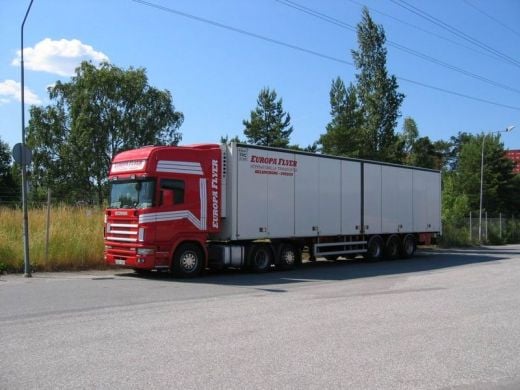Prevent Commerical Truck and Trailer Theft

- National Insurance Crime Bureau
A not-for-profit organization that receives support from approximately 1,000 property/casualty insurance companies. It partners with insurers and law enforcement agencies to detect and prosecute insurance criminals.
Protect Your Business
Any business that has motor vehicle operations should carefully consider a security program to protect trucks, trailers, employees, and cargoes. According to a crime report published by the Federal Bureau of Investigation, there were approximately 1.2 million motor vehicle thefts in the United States in 2005, with losses estimated at $7.6 billion. Almost 18 percent of stolen vehicles were commercial trucks or buses which were taken for resale or, with increasing frequency, “chopped” for parts.
The loss of the vehicle itself is only a faction of the cost. When power equipment is stolen, companies face business interruptions, parts shortages, angry customers, revenue loss, and higher insurance premiums. Cargo theft takes an even greater toll, accounting for as much as $25 billion in direct merchandise losses each year in the United States. Violent hijackings create workers’ compensation and general liability exposures if employees are traumatized, injured, or worse during the crime.
Many such losses can be prevented if management and operators implement some basic security measures to make vehicles less vulnerable or desirable to thieves, and easier to recover if they are stolen. The National Insurance Crime Bureau recommends that every well-designed vehicle security plan have four layers of protection that cover the vehicles, trailers, and drivers: common sense, warning and anti-theft devices, immobilizing devices, and tracking devices.
Layer 1: Common Sense Measures
Basic security measure can usually prevent crimes of opportunity or stop unsophisticated thieves. The simplest theft deterrent is to shut off the engine, remove the ignition key, close the windows, and lock the doors anytime the vehicle is left unattended, even if it is “just for a moment”. Other common sense tips:
- Do not hide spare keys in or under the vehicle.
- Never put an identification tag on a vehicle key ring that directly identifies the vehicle. A lost key ring can lead a thief right to the vehicle.
- Park safely. Park in an attended lot whenever possible. If this is not practical, choose a well-lighted and fenced lot, or a busy area that is clearly visible from the street.
- Do not leave windows “cracked” for ventilation. Thieves have tools that can unlock vehicles through a minimal open space.
- Forbid unauthorized passengers, especially hitchhikers.
- Install locking cargo doors on trailers and keep them locked.
- Make high-value cargo less accessible to theft by placing it in the front of the trailer with normal cargo in back.
- Use king-pins locks on parked trailers.
Instruct operators how to drive safely:
- Keep doors locked and windows closed, especially when stopped in traffic or at traffic lights.
- When stopped in traffic, always leave enough room to make an emergency escape.
- Carefully plan vehicle routing and restrict travel to major roads whenever possible. Avoid lightly-traveled streets, especially after dark.
- Instruct drivers not to deviate from the route and avoid unnecessary stops. Choose eating and rest areas with security in mind.
- Keep motor equipment in good repair to avoid breakdowns. Drivers should not let fuel tanks get below one-quarter full.
- Be wary of persons indicating there is something wrong with a vehicle, asking for directions (especially in parking areas), or attempting to flag them down. Ensure drivers carry radios or cell phones so they can remain in the vehicle and summon help.

Layer 2: Warning and Anti-Theft Devices
Vehicle security alarm systems and anti-theft devices include detectors, audible alarms, steering wheel locks, and theft deterrent decals. These deter or discourage thieves, and alert others of forced entry into the truck. Some systems are quite sophisticated and will even send an automatic alert to a central station or pager if a vehicle is moved without authorization. Such systems, however, only buy time and will not prevent a determined thief from stealing the vehicle. Consequently, alarm and anti-theft systems should always be used in combination with other prevention measures.
- GPS World magazine covering GNSS news for industry professionals. | GPS World
GPS World magazine. GPS and GNSS industry news and developments in the business and technology of global positioning, navigation, and timing. - Magellan RoadMate 1700 GPS Device
Computer world article on a portable GPS navigation device suitable for large vehicles such as trucks and RVs. - Global Positioning System
Public information about the Global Positioning System (GPS) and other space-based positioning, navigation, and timing (PNT) systems
Layer 3: Immobilizing Devices
Vehicle immobilizer systems prevent thieves from taking the truck under its own power by disabling vital automotive functions and preventing the engine from being restarted until a hidden switch is activated. Other types, such as fuel cut-off devices, allow the vehicle to operate a short time and then stall out. Disabled vehicles, however, can still be towed away, making the fourth layer of security necessary.
Layer 4: Tracking Devices
The final layer of security is a
tracking device that enables owners or the police to track the location of the
vehicle and recover it faster with less damage or loss of cargo. Most systems now use Global
Positioning System (GPS), which sends vehicle information (such as
speed, direction of travel, or location) to a remote user. Police can simply follow the signal emitted by the tracking system or
view vehicle position on an electronic map.
When coupled with an automatic alert system to a central station,
tracking devices have been known to lead police to stolen high-value cargo
trailers before they could towed even a few miles away. GPS is also used by fleet operators to
assist in routing, dispatch, and monitoring driver behavior, but can double as
theft prevention and a retrieval device.
Summary
Professional vehicle-theft rings are cunning and skilled, but implementing Layer 1 security basics may persuade them to move to easier targets. Layer 2 and 3 precautions will discourage crimes of opportunity or less sophisticated thieves, and buy time if a pro is involved. Layer 4 tracking devices can assist in implementing Layer 1 security measures, such as safer routing and driver monitoring, and may help in the faster recovery of stolen vehicles or cargo. Businesses cannot afford the cost and disruption of vehicle and cargo theft. The four-layered vehicle security program is an investment well worth investigating.



